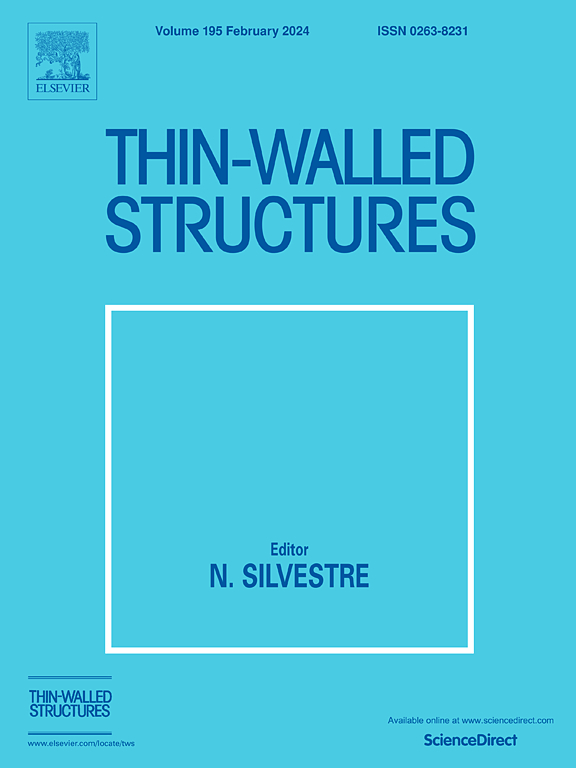Compressive behavior of a novel cold-formed steel built-up box section: Tests, modelling and design
IF 5.7
1区 工程技术
Q1 ENGINEERING, CIVIL
引用次数: 0
Abstract
This paper investigates a novel built-up box section constructed from single cold-formed steel (CFS) C- and U-sections, which are connected using self-drilling screws along their extended flanges. Both experimental and numerical analyses were conducted to study the buckling behavior and ultimate strength of these pin-ended, axially loaded CFS built-up box section columns. The study focuses on key parameters such as thicknesses (0.95 mm and 1.15 mm), screw spacing (300 mm and 600 mm), and slenderness ratios (42, 72, 102, 132). A total of 48 specimens were tested under axial compression, exhibiting significant local-distortional and local-flexural interactive buckling modes. Finite element models were developed using ABAQUS software and validated based on the experimental results. The numerical simulations were used to assess the effects of screw spacing and thickness on the ultimate strength of the built-up box columns. The ultimate strengths obtained from both the experiments and the finite element analysis were then compared to the predictions made using the Effective Width Method (EWM) and the Direct Strength Method (DSM), as outlined in AISI S100 (2016) and AS/NZS 4600 (2018). The comparison shows that DSM overestimated the axial capacity of these novel built-up box section columns by an average of 15 %, while EWM was overly conservative, with mean experimental-to-design strength ratios exceeding 2.5.
本文研究了一种由单个冷弯型钢(CFS)C 型截面和 U 型截面构成的新型内置箱形截面,这些截面使用自钻螺钉沿其扩展翼缘进行连接。通过实验和数值分析,研究了这些销端轴向加载 CFS 构建箱形截面柱的屈曲行为和极限强度。研究的重点是厚度(0.95 毫米和 1.15 毫米)、螺钉间距(300 毫米和 600 毫米)和细长比(42、72、102、132)等关键参数。共对 48 个试样进行了轴向压缩测试,结果显示出显著的局部扭曲和局部挠性交互屈曲模式。使用 ABAQUS 软件开发了有限元模型,并根据实验结果进行了验证。数值模拟用于评估螺杆间距和厚度对加固箱形柱极限强度的影响。实验和有限元分析得出的极限强度与 AISI S100 (2016) 和 AS/NZS 4600 (2018) 中概述的有效宽度法 (EWM) 和直接强度法 (DSM) 的预测值进行了比较。比较结果表明,DSM 高估了这些新型内置箱形截面柱的轴向承载力,平均高估了 15%,而 EWM 则过于保守,实验强度与设计强度的平均比值超过了 2.5。
本文章由计算机程序翻译,如有差异,请以英文原文为准。
求助全文
约1分钟内获得全文
求助全文
来源期刊

Thin-Walled Structures
工程技术-工程:土木
CiteScore
9.60
自引率
20.30%
发文量
801
审稿时长
66 days
期刊介绍:
Thin-walled structures comprises an important and growing proportion of engineering construction with areas of application becoming increasingly diverse, ranging from aircraft, bridges, ships and oil rigs to storage vessels, industrial buildings and warehouses.
Many factors, including cost and weight economy, new materials and processes and the growth of powerful methods of analysis have contributed to this growth, and led to the need for a journal which concentrates specifically on structures in which problems arise due to the thinness of the walls. This field includes cold– formed sections, plate and shell structures, reinforced plastics structures and aluminium structures, and is of importance in many branches of engineering.
The primary criterion for consideration of papers in Thin–Walled Structures is that they must be concerned with thin–walled structures or the basic problems inherent in thin–walled structures. Provided this criterion is satisfied no restriction is placed on the type of construction, material or field of application. Papers on theory, experiment, design, etc., are published and it is expected that many papers will contain aspects of all three.
 求助内容:
求助内容: 应助结果提醒方式:
应助结果提醒方式:


